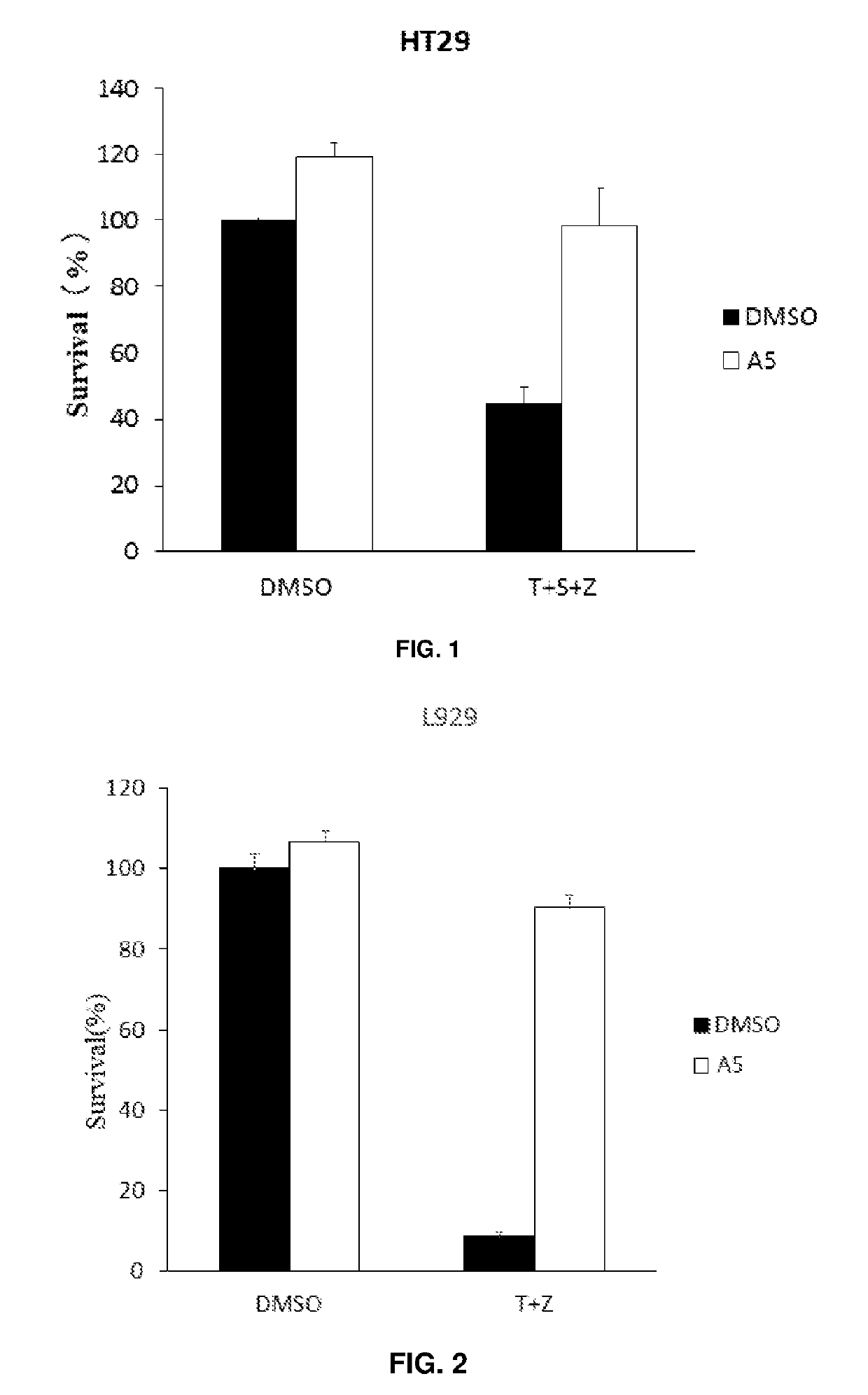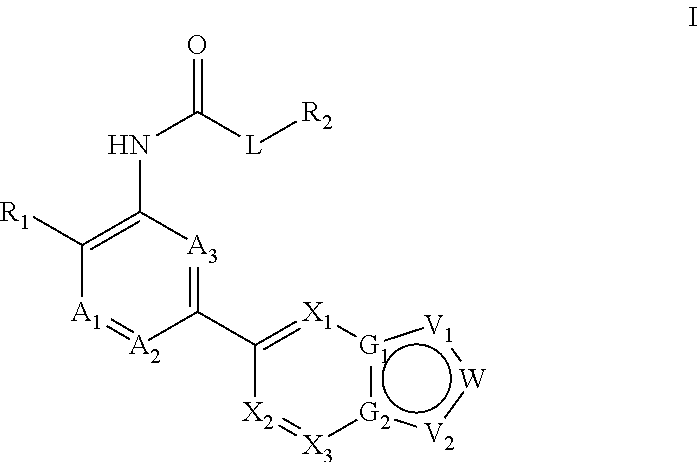Heteroaryl compounds as inhibitors of necrosis, composition and application thereof
a technology of heteroaryl compounds and necrosis inhibitors, applied in the field of heteroaryl compounds, can solve the problems of necrosis, cytoplasmic and organelle swelling and eventual lysis of cells, inflammatory response, local or total cerebral ischemia and hypoxia, and achieve the effect of inhibiting necrosis
- Summary
- Abstract
- Description
- Claims
- Application Information
AI Technical Summary
Benefits of technology
Problems solved by technology
Method used
Image
Examples
example 1
A42 Made by Method A
[0105]
Step 1: N-(6-bromobenzo[d]thiazol-2-yl)acetamide
[0106]To a stirred solution of 6-bromobenzo[d]thiazol-2-amine (2.50 g, 10.7 mmol) and DMAP (1.33 g, 12.8 mmol) in 20 mL dichloromethane at 0° C., Ac2O (1.23 mL, 13.0 mmol) was added dropwise. After carried out at r.t. overnight, the mixture was quenched with 100 mL 1 N HCl. The resulting precipitate was filtered. The cake was washed with water and dried under vacuum to give A42-1 as a white solid (2.30 g, 79%). 1H NMR (300 MHz, CDCl3) δ 9.90 (br s, 1H), 7.94 (s, 1H), 7.61 (d, J=10.4 Hz, 1H), 7.54 (d, J=10.4 Hz, 1H), 2.30 (s, 3H).
Step 2: N-(6-(4,4,5,5-tetramethyl-1,3,2-dioxaborolan-2-yl)benzo-[d]thiazol-2-yl) Acetamide
[0107]A 100 mL flask was charged with A42-1 (2.10 g, 7.75 mmol), bis(pinacolato)diboron (3.00 g, 11.8 mmol), KOAc (3.00 g, 30.6 mmol) and Pd(dppf)Cl2 (560 mg, 0.765 mmol) followed by addition of 50 mL DMSO. The equipment was evacuated and refilled with N2 three times. The reaction was carried out ...
example 2
A36 Made by Method D
[0110]
A Step 1: cyclohexyl (4-nitrophenyl) carbonate
[0111]To a stirred solution of cyclohexanol (12.0 g, 118 mmol) and DMAP (1.2 g, 9.9 mmol) in 50 mL THF at 0° C. was added 4-nitrophenyl carbonochloridate A36-1 (20 g, 99 mmol) in partitions. The reaction was carried out at r.t. for 4 h. After the solvent removed by vacuum, the residue was purified by column chromatography (petroleum ether:ethyl acetate=100:2) to give A36-2 as a white solid (12.4 g, 47%).
Step 2: cyclohexyl (5-bromo-2-methylpyridin-3-yl)carbamate
[0112]To a stirred solution of 5-bromo-2-methyl-pyridin-3-amine (1.4 g, 7.6 mmol) in 20 mL anhydrous THF at 0° C., NaHMDS (2 M, 8 mL, 16 mmol) was added dropwise. After stirred for 15 min, a solution of A36-2 (2.4 g, 9.1 mmol) in 5 mL anhydrous THF was added dropwise. The reaction was carried out at 0° C. for another 15 min. After that, the reaction was quenched with water. The mixture was diluted with ethyl acetate. The organic phase was washed with 1 N N...
example 3
A37 Made by Method B
[0114]
Step 1: cyclohexyl (5-(2-aminobenzo[d]thiazol-6-yl)-2-methylpyridin-3-yl)carbamate (A70)
[0115]A mixture of A36 (300 mg, 0.71 mmol) and one drop of con. HCl in MeOH was heated to 60° C. overnight. After cooled to r.t., the mixture was basified by sat. aq. NaHCO3. The aqueous phase was extracted with ethyl acetate. The combined organic phases were dried over Na2SO4 and the solvent was removed by vacuum to give a white solid (220 mg, 81%). 1H NMR (400 MHz, DMSO-d6) δ 9.09 (s, 1H), 8.52 (s, 1H), 8.02 (s, 1H), 8.00 (s, 1H), 7.60 (s, 2H), 7.51 (d, J=8.4 Hz, 1H), 7.40 (d, J=8.4 Hz, 1H), 4.74-4.51 (m, 1H), 2.43 (s, 3H), 1.95-1.87 (m, 2H), 1.78-1.65 (m, 2H), 1.58-1.21 (m, 6H).
Step 2: cyclohexyl (2-methyl-5-(2-propionamidobenzo[d]thiazol-6-yl)pyridin-3-yl)carbamate (A37)
[0116]A mixture of A70 (30 mg, 0.08 mmol), propionic acid (12 mg, 0.16 mmol), HATU (63 mg, 0.16 mmol) and TEA (17 mg, 0.16 mmol) in 1 mL DMF was stirred at r.t. overnight. After that, the mixture was ...
PUM
| Property | Measurement | Unit |
|---|---|---|
| detecting wavelength | aaaaa | aaaaa |
| detecting wavelength | aaaaa | aaaaa |
| flow rate | aaaaa | aaaaa |
Abstract
Description
Claims
Application Information
 Login to View More
Login to View More - R&D
- Intellectual Property
- Life Sciences
- Materials
- Tech Scout
- Unparalleled Data Quality
- Higher Quality Content
- 60% Fewer Hallucinations
Browse by: Latest US Patents, China's latest patents, Technical Efficacy Thesaurus, Application Domain, Technology Topic, Popular Technical Reports.
© 2025 PatSnap. All rights reserved.Legal|Privacy policy|Modern Slavery Act Transparency Statement|Sitemap|About US| Contact US: help@patsnap.com



